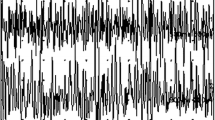Abstract
Purpose of Review
Injury to the external branch of the superior laryngeal nerve (EBSLN), resulting in paresis of the nerve and limited muscle activation of the cricothyroid muscle, is highly disruptive for individuals who use their voice as a significant part of their occupation and/or to improve quality of life.
Recent Findings
A single-subject case study is presented describing a long-term, team-based approach to voice care for an occupational voice user with damage to the right external branch of the superior laryngeal nerve (EBSLN).
Summary
While it is unclear that improvement of nerve function is possible outside the 6–12-month window of spontaneous regeneration, this case provides an example of how continued support and coaching over several years resulted in improved phonation and functional voice-quality outcomes for the patient.


Similar content being viewed by others
References
Sakorafas GH, Kokoropoulos P, Lappas C, Sampanis D, Smyrniotis V. External branch of the superior laryngeal nerve: applied surgical anatomy and implications in thyroid surgery. Am Surg. 2012;78(9):986–91.
Teitelbaum BJ, Wenig BL. Superior laryngeal nerve injury from thyroid surgery. Head & Neck. 1995;17(1):36-40. https://doi.org/10.1002/hed.2880170108.
Dursun G, Sataloff RT, Spiegel JR, Mandel S, Heuer RJ, Rosen DC. Superior laryngeal nerve paresis and paralysis. J Voice. 1996;10(2):206-11. https://doi.org/10.1016/s0892-1997(96)80048-8.
Iwata AJ, et al. Superior laryngeal nerve signal attenuation influences voice outcomes in thyroid surgery. Laryngoscope. 2021;131(6):1436–42. https://doi.org/10.1002/lary.29413.
Orestes MI, Chhetri DK. Superior laryngeal nerve injury: effects, clinical findings, prognosis, and management options. Curr Opin Otolaryngol Head Neck Surg. 2014;22(6):439–43. https://doi.org/10.1097/MOO.0000000000000097.
Marchese-Ragona R, et al. The superior laryngeal nerve injury of a famous soprano, Amelita Galli-Curci. Acta Otorhinolaryngol Ital. 2013;33(1):67–71.
Lu L, Charney S, Pittelko R, Ochoa P, Bayan SL, Lohse C, Orbelo DM. Singing Voice Concern in Tertiary Laryngology Practice. J Voice. 2023. https://doi.org/10.1016/j.jvoice.2022.12.013.
Orbelo DM, Charney S, Pietrowicz M, Aka D, Bayan S, Ishikawa K. Vocal effort and acoustic analysis of gargle phonation versus water swallow in patients with mild muscle tension dysphonia: a clinical trial. Manuscript submitted for publication.
Yiu EM-L, Lo MCM, Barrett EA. A systematic review of resonant voice therapy. Int J Speech Lang Pathol. 2017;19(1):17–29. https://doi.org/10.1080/17549507.2016.1226953.
Verdolini Abbott K. Lessac-Madsen Resonant Voice Therapy Clinician Manual. Oxfordshire, UK: Plural Publishing Inc. 2008.
Steinhauer KM, McDonald Klimek M. Vocal traditions: estill voice Training®. Voice and Speech Rev. 2019;13(3):354-9.
Orbelo D, Burke T. Creating space: using joint openers, cartoon dogs, and overtoning to smooth transitions, increase versatility and more. Philadelphia, PA: Workshop at The Voice Foundation 48th Annual Symposium Care of the Professional Voice; 2019.
Guzmán M, et al. Air pressure and contact quotient measures during different semioccluded postures in subjects with different voice conditions. J Voice. 2016;30(6):759.e1–10. https://doi.org/10.1016/j.jvoice.2015.09.010.
Cohen SM, et al. Creation and validation of the singing voice handicap index. Ann Otol Rhinol Laryngol. 2007;116(6):402–6.
Jacobson BH, et al. The voice handicap index (VHI). Am J Speech Lang Pathol. 1997;6(3):66–70. https://doi.org/10.1044/1058-0360.0603.66.
Rosen CA, Lee AS, Osborne J, Zullo T, Murry T. Development and validation of the voice handicap index-10. Laryngoscope. 2004;114(9):1549–56. https://doi.org/10.1097/00005537-200409000-00009.
Phyland DJ, Oates J, Greenwood KM. Self-reported voice problems among three groups of professional singers. J Voice. 1999;13(4):602–11. https://doi.org/10.1016/s0892-1997(99)80014-9.
Barsties B, Maryn Y. The improvement of internal consistency of the Acoustic Voice Quality Index. Am J Otolaryngol. 2015;36(5):647–56. https://doi.org/10.1016/j.amjoto.2015.04.012.
Maryn Y, De Bodt M, Barsties B, Roy N. The value of the acoustic voice quality index as a measure of dysphonia severity in subjects speaking different languages. Eur Arch Otorhinolaryngol. 2014;271(6):1609–19. https://doi.org/10.1007/s00405-013-2730-7.
Maryn Y, Corthals P, Van Cauwenberge P, Roy N, De Bodt M. Toward improved ecological validity in the acoustic measurement of overall voice quality: combining continuous speech and sustained vowels. J Voice. 2010;24(5):540–55. https://doi.org/10.1016/j.jvoice.2008.12.014.
Funding
This work is partially supported by a grant from the National Institutes of Health, NIDCD R01 DC018280 (Ingo R. Titze—PI).
Author information
Authors and Affiliations
Corresponding author
Ethics declarations
Conflict of Interest
The authors declare no competing interests.
Human and Animal Rights and Informed Consent
All reported studies/experiments with human or animal subjects performed by the authors have been previously published and complied with all applicable ethical standards (including the Helsinki declaration and its amendments, institutional/national research committee standards, and international/national/institutional guidelines).
Additional information
Publisher's Note
Springer Nature remains neutral with regard to jurisdictional claims in published maps and institutional affiliations.
Rights and permissions
Springer Nature or its licensor (e.g. a society or other partner) holds exclusive rights to this article under a publishing agreement with the author(s) or other rightsholder(s); author self-archiving of the accepted manuscript version of this article is solely governed by the terms of such publishing agreement and applicable law.
About this article
Cite this article
Maxfield, L., Orbelo, D.M. Singing After Superior Laryngeal Nerve Weakness: A Story of Hope. Curr Otorhinolaryngol Rep 11, 307–311 (2023). https://doi.org/10.1007/s40136-023-00484-z
Accepted:
Published:
Issue Date:
DOI: https://doi.org/10.1007/s40136-023-00484-z




